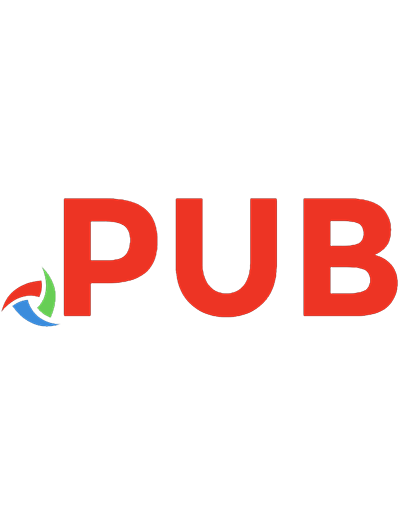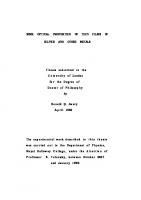Handbook on the Properties of Niobium, Moybdenum, Tantalum, Tungsten and some of their Alloys
In the pursuit of materials inherently capable of operating at temperatures above approximately 1000 °C (or approximatel
119 91 4MB
English Pages XXI; 301 [323] Year 1965
Polecaj historie
Table of contents :
Table of Contents
INTRODUCTION
LIST OF ABBREVIATIONS
CHAPTER I - NIOBIUM AND NIOBIUM ALLOYS
1. PHYSICAL PROPERTIES OF NIOBIUM METAL
2. MECHANICAL PROPERTIES OF NIOBIUM METAL
3. CORROSION BY GASES, CHEMICALS AND LIQUID METALS
4. FABRICATION
5. NIOBIUM ALLOYS - PURPOSE AND COMPOSITION
6. PHYSICAL PROPERTIES OF SOME ALLOYS
7. MECHANICAL PROPERTIES OF SOME ALLOYS
8. CORROSION OF ALLOYS BY GASES, CHEMICALS ANDLIQUID METALS
9. FABRICATION
CHAPTER II - TANTALUM AND TANTALUM ALLOYS
1. PHYSICAL PROPERTIES OF TANTALUM METAL
2. MECHANICAL PROPERTIES OF TANTALUM METAL
3. CORROSION BY GASES, CHEMICALS AND LIQUID METALS
4. FABRICATION
5. TANTALUM ALLOYS
6. PHYSICAL PROPERTIES OF SOME ALLOYS
7. MECHANICAL PROPERTIES OF SOME ALLOYS
8. CORROSION OF ALLOYS BY GASES, CHEMICALS AND
9. FABRICATION
CHAPTER III - MOLYBDENUM AND MOLYBDENUM ALLOYS
1. PHYSICAL PROPERTIES OF MOLYBDENUM METAL
2. MECHANICAL PROPERTIES OF MOLYBDENUM METAL
3. CORROSION BY GASES, CHEMICALS AND LIQUID METALS
4. FABRICATION
5. MOLYBDENUM ALLOYS
6. PHYSICAL PROPERTIES OF SOME ALLOYS
7. MECHANICAL PROPERTIES OF SOME ALLOYS
8. CORROSION BY GASES, CHEMICALS AND LIQUID METALS
9. FABRICATION
CHAPTER IV - TUNGSTEN AND TUNGSTEN ALLOYS
1. PHYSICAL PROPERTIES OF TUNGSTEN METAL
2. MECHANICAL PROPERTIES OF TUNGSTEN METAL
3. CORROSION BY GASES, CHEMICALS AND LIQUID METALS
4. FABRICATION
5. TUNGSTEN ALLOYS
6. PHYSICAL PROPERTIES OF ALLOYS
7. MECHANICAL PROPERTIES
8. CORROSION BY GASES AND CHEMICALS
9. FABRICATION
10. COMPARISON OF THE TENSILE STRENGTH OF REFRACTORY METALS AND THEIR ALLOYS
CHAPTER V - PROTECTIVE COATINGS
1. GENERAL
2. PROTECTIVE COATINGS FOR NIOBIUM AND NIOBIUM ALLOYS
3. PROTECTIVE COATINGS FOR TANTALUM AND TANTALUM ALLOYS
4. PROTECTIVE COATINGS FOR MOLYBDENUM AND MOLYBDENUM ALLOYS
5. PROTECTIVE COATINGS FOR TUNGSTEN AND TUNGSTEN ALLOYS
6. SUMMARY OF PERFORMANCE OF COATED REFRACTORY METALS
SELECTED BIBLIOGRAPHY
DISTRIBUTION
Remark: There is no page #1 due to special formatting English / French
Citation preview
CONTENTS
Page INTRODUCTION
ii
LIST OF ABBREVIATIONS
xx
CHAPTER I - NIOBIUM AND NIOBIUM ALLOYS 1. PHYSICAL PROPERTIES OF NIOBIUM METAL 1.1 Atomic Number 1.2 Crystal Structure 1.3 Density 1.4 Melting Point 1.5 Vapour Pressure 1.6 Specific Heat 1.7 Thermal Conductivity 1.8 Thermal Expansion 1.9 Electrical Resistivity 1.10 Absorption Cross-Section (Thermal Neutrons) 1.11 Spectral Emissivity 2. MECHANICAL PROPERTIES OF NIOBIUM METAL 2.1 Typical Analyses 2.2 Tensile Properties at High Temperature (Mean values) 2.3 Tensile Properties at Low Temperature Ductile-to-Brittle Transition 2.4 Hardness 2.5 Young's Modulus 2.6 Fatigue Strength 2.7 Creep Properties 2.7.1 Stress-Rupture Data 2.7.2 Creep Stress 2.8 Effect of Impurities (Oxygen and Nitrogen) 2.8.1 Effect on Properties at Room Temperature (Annealed metal) 2.8.2 Effect on Properties at High Temperatures (Annealed metal) , 2.8.3 Effect on Hardness at Room Temperature (Annealed metal) 2.9 Cold Working, Stress-Relief and Recrystallization 2.9.1 Cold Working 2.9.2 Stress-Relief 2.9.3 Recrystallization
iv
2 2 2
2 2 2 2 2 2
4 5
5 5 5
6 6 10 10 10 10 10 12 12
12 12 14 14 14 14 14
Page 3. CORROSION BY GASES, CHEMICALS AND LIQUID METALS 3.1 Resistance to Oxidation 3.2 Resistance to Water and Water Vapour 3.3 Resistance to Various Chemicals 3.4 Resistance to Liquid Metals
16 16
4. FABRICATION 4.1 Welding and Brazing 4.2 Forming 4.3 Machining
20 20 20
18 20 20
22
5. NIOBIUM ALLOYS - PURPOSE AND COMPOSITION 5.1 General 5.2 Solid Solution Strengthening 5.3 Dispersion Strengthening 5.4 Composition of Niobium Alloys
22 22
22 24 26
6. PHYSICAL PROPERTIES OF SOME ALLOYS
30
7. MECHANICAL PROPERTIES OF SOME ALLOYS 7.1 Tensile Properties at High Temperatures (Mean values) 7.2 Materials Advisory Board Targets 7.3 Creep Properties 7.3.1 Stress-Rupture 7.3.2 Creep Stress 7.4 Young's Modulus 7.5 Stress Relief and Recrystallization 7.6 Ductile-to-Brittle Transition Temperature
32
38 42 44 44
8. CORROSION OF ALLOYS BY GASES, CHEMICALS AND LIQUID METALS 8.1 Resistance to Oxidation. General 8.1.1 Resistance to Oxidation of Some Common Alloys 8.2 Resistance to Water and Water Vapour 8.3 Resistance to Chemicals 8.4 Resistance to Liquid Metals
48 48 52 52 52 52
9. FABRICATION 9.1 Welding
54 54
32 36 36 36
9.2
Brazing
56
9.3 9.4 9.5
Forming Machining Descaling
58
62 62
vi
Page CHAPTER II - TANTALUM AND TANTALUM ALLOYS 1. PHYSICAL PROPERTIES OF TANTALUM METAL 1.1 Atomic Number 1.2 Crystal Structure 1.3 Density 1.4 Melting Point 1.5 Vapour Pressure 1.6 Specific Heat 1.7 Thermal Conductivity 1.8 Thermal Expansion (Mean) 1.9 Electrical Resistivity 1.10 Absorption Cross-Section (Thermal Neutrons) 1.11 Spectral Emissivity
64 64 64 64 64 64 66 66
2. MECHANICAL PROPERTIES OF TANTALUM METAL 2.1 Typical Analyses 2.2 Tensile Properties at High Temperatures (Mean Values) 2.3 Tensile Properties at Low Temperatures - Ductile-toBrittle Transition 2.4 Hardness 2.5 Young's IYlodulus 2.6 Fatigue Strength 2.7 Creep Properties 2.7.1 Stress Rupture Data (Mean values) 2.7.2 Creep Stress 2.8 Effect of Impurities 2.9 Cold-Working - Stress-Relief - Recrystallization 2.9.1 Cold-Working 2.9.2 Stress-Relief 2.9.3 Recrystallization
68 68
66 66 68 68
70 70 72 72 72 74 74 74 74 76 76 76 76
3. CORROSION BY GASES, CHEMICALS AND LIQUID METALS 3.1 Resistance to Oxidation 3.2 Resistance to Various Chemicals 3.3 Effect of Hydrogen 3.4 Resistance to Liquid Metals
80 80 80
4. FABRICATION 4.1 Welding and Brazing
82 82
4.2
Forming and Machining
78 78
82
5. TANTALUM ALLOYS 5.1 General 5.2 Solid Solution Strengthening 5.3 Dispersion Strengthening 5.4 Composition of Some Alloys
viii
82 82 84
86 86
Page 6. PHYSICAL PROPERTIES OF SOME ALLOYS
90
7. MECHANICAL PROPERTIES OF SOME ALLOYS 7.1 Tensile Properties at High Temperatures (Mean values) 7.2 Materials Advisory Board Targets 7.3 Creep Properties 7.3.1 Stress Rupture Data 7.3.2 Creep Stress 7.4 Young's Modulus 7.5 Stress-Relief and Recrystallization 7.6 Ductile-to-Brittle Transition Temperature
90 90 92 94 94 94 96 96 96
S. CORROSION OF ALLOYS BY GASES, CHEMICALS AND LIQUID METALS S.l Resistance to Oxidation - General S.2 Resistance to Chemicals S.3 Resistance to Liquid Metals
9S 9S 100 100
9. FABRICATION
9.1 9.2 9.3 9.4 9.5
100 100 102 102 106 106
Welding Brazing Forming Machining Descaling
CHAPTER III - MOLYBDENUM AND MOLYBDENUM ALLOYS 1. PHYSICAL PROPERTIES OF MOLYBDENUM METAL 1.1 Atomic Number 1.2 Crystal Structure 1. 3 Densi ty 1.4 Melting Point 1.5 Vapour Pressure 1.6 Specific Heat 1.7 Thermal Conductivity 1.S Thermal Expansion 1.9
Electrical Resistivity
1.10 Absorption Cross-Section (Thermal Neutrons) 1.11 Spectral Emissivity 2. MECHANICAL PROPERTIES OF MOLYBDENUM METAL 2. 1 Typical Analyses 2.2 Tensile Properties at High Temperatures (Mean values) 2.3 Tensile Properties at Low Temperatures Ductile-Brittle Transition
x
lOS lOS lOS lOS 108
lOS lOS 110 110 110 110 110
112 112
112 114
Page 2.4 2.5 2.6 2.7
2.8 2.9
Hardness Young's Modulus (Mean values) Fatigue strength Creep Properties 2.7.1 stress-Rupture Data 2.7.2 Creep stress Effects of Impurities Cold-Working - stress-Relief - Recrystallization 2.9.1 Cold-Working 2.9.2 Stress-Relief 2.9.3 Recrystallization
3. CORROSION BY GASES, 3.1 Resistance to 3.2 Resistance to 3.3 Resistance to
CHEMICALS AND LIQUID METALS Oxidation Various Chemicals Liquid Metals
120 120 120 122 122 122 122 124 124 124 124 126 126 128 128
4. FABRICATION 4.1 Welding 4.2 Forming 4.3 Machining
128 128 130 130
5. MOLYBDENUM ALLOYS 5.1 General 5.1.1 Improvement of Resistance to Oxidation 5.1.2 Improvement of Recrystallization Temperature 5.1.3 Improvement of Mechanical Properties at High Temperature 5.1.3.1 Dispersion Strengthening 5.1.3.2 Solid Solution Strengthening 5.1.4 Improvement of Welding Properties
132 132 132 132 132 132 134 138
6. PHYSICAL PROPERTIES OF SOME ALLOYS 6.1 Composition of Principal Alloys 6.2 Physical Properties
138 138 140
7. MECHANICAL PROPERTIES OF SOME ALLOYS 7.1 Tensile Properties at High Temperatures (Mean values) 7.2 Materials Advisory Board Targets 7.3 Creep Properties 7.3.1 Stress-Rupture Data 7.3.2 Creep Stress 7.4 Young's Modulus 7.5 Stress-Relief and Recrystallization 7.6 Ductile-to-Brittle Transition Temperature
142
xii
142 144 146
146 148 150 150 152
Page 8. CORROSION BY GASES, CHEMICALS AND LIQUID METALS 8.1 Resistance to Oxidation 8.2 Resistance to Corrosion by Chemicals and Liquid IVietal
158 158
9. FABRICATION 9.1 Welding 9.2 Brazing 9.3 Forming 9.4 Machining
160 160 162 164 166
160
CHAPTER IV - TUNGSTEN AND TUNGSTEN ALLOYS 1. PHYSICAL PROPERTIES OF TUNGSTEN METAL 1.1 Atomic Number 1.2 Crystal Structure 1. 3 Densi ty 1.4 Melting Point 1.5 Vapour Pressure 1.6 Specific Heat 1.7 Thermal Conductivity 1.8 Thermal Expansion 1.9 Electrical Resistivity 1.10 Absorption Cross-Section (Thermal Neutrons) 1.11 Spectral Emissivity
168 168 168 168 168 168 168 168 170 170 170 170
2. MECHANICAL PROPERTIES OF TUNGSTEN METAL 2.1 Typical Analyses 2.2 Tensile Properties at High Temperatures (Mean values) 2.3 Ductile-to-Brittle Transition 2.4 Hardness 2.5 Young's Modulus 2.6 Fatigue Strength 2.7 Creep Properties 2.7.1 Stress Rupture Data 2.7.2 Creep Stress
170 170 172 174 176 178 178 178 178 178
2.8
Effect of Impurities
178
2.9
Cold-Working - Stress-Relief - Recrystallization 2.9.1 Cold-Working 2.9.2 Stress-Relief 2.9.3 Recrystallization
180 180 180 180
xiv
Page 3. CORROSION BY GASES, 3.1 Resistance to 3.2 Resistance to 3.3 Resistance to 3.4 Compatibility
CHEMICALS AND LIQUID METALS Oxidation Chemicals Liquid Metals with Refractory Materials
182 182 182 182 184
4. FABRICATION 4.1 Welding 4.2 Forming 4.3 Machining
184 184 184 186
5. TUNGSTEN ALLOYS 5.1 General 5.2 Improvement of Mechanical Properties of Wrought Alloys at High Temperatures 5.2.1 Solid Solution Strengthening 5.2.2 Dispersion Strengthening 5.2.3 Combinations of Solid Solution and Dispersion Strengthening 5.3 Alloys Produced by Liquid Phase Sintering or Infiltration
186 186 186 186 190 192 194
PHYSICAL PROPERTIES OF ALLOYS 6.1 Composition of the Most Advanced Alloys 6.2 Physical Properties
194 194 196
7. MECHANICAL PROPERTIES 7.1 Tensile Properties at High Temperatures (Experimental values) 7.2 Materials Advisory Board Targets 7.3 Creep Properties 7.3.1 Stress Rupture 7.3.2 Creep Stress 7.4 Stress-Relief and Recrystallization 7.5 Ductile-to-Brittle Transition
196
6.
196 200 200 200 202 202 206
8.
CORROSION BY GASES AND CHEMICALS 8.1 Resistance to Oxidation 8.2 Corrosion by Chemicals
208 208 210
9.
FABRICATION 9.1 Welding 9.2 Brazing and Diffusion Bonding 9.3 Forming 9.4 Machining
210
10. COMPARISON OF THE TENSILE STRENGTH OF REFRACTORY METALS AND THEIR ALLOYS
xvi
210 210 212 214
214
Page CHAPTER V - PROTECTIVE COATINGS 1. GENERAL 1.1 Essential Requirements for Protective Coatings 1.2 Brief Review of the Most Advanced Protective Coatings
220 220 224
2. PROTECTIVE COATINGS FOR NIOBIUM AND NIOBIUM ALLOYS 2.1 Types of Coating 2.1.1 Spray Metallisation 2.1.2 Hot-Dipping 2.1.3 Cementation and Diffusion 2.1.4 Metal Cladding 2.2 Performance of Coatings and Effect of Transition Temperature
224 224 226 228 232 238
3. PROTECTIVE COATINGS FOR TANTALUM AND TANTALUM ALLOYS 3.1 Types of Coating 3.1.1 Aluminides (General Telephone and Electronics) 3.1.2 Beryllides (General Telephone and Electronics) 3.1.3 Silicides 3.1.4 Metal + Ceramic
242 242 244 246 246 248
4. PROTECTIVE COATINGS FOR MOLYBDENUM AND MOLYBDENUM ALLOYS 4.1 Types of Coating 4.1.1 Silicides 4.1.2 Sprayed Metals or Alloys 4.1.3 Electroplating 4.1.3.1 Metals 4.1.3.2 Metals + Ceramics 4.1.4 Miscellaneous
250 250 252 260 262 262 262 262
5. PROTECTIVE COATINGS FOR TUNGSTEN AND TUNGSTEN ALLOYS 5.1 Types of Coating 5.1.1 Silicides 5.1.2 Metals 5.1.3 Ceramics 5.2 Miscellaneous
264 264 266 268 270 270
6. SUMMARY OF PERFORMANCE OF COATED REFRACTORY METALS 6.1 Summary of Mean Performances 6.2 Current Maximum Performances
272 272 272
SELECTED BIBLIOGRAPHY
277
DISTRIBUTION
xviii
238



![Copper Alloys: Preparation, Properties and Applications : Preparation, Properties and Applications [1 ed.]
9781620815441, 9781612095042](https://dokumen.pub/img/200x200/copper-alloys-preparation-properties-and-applications-preparation-properties-and-applications-1nbsped-9781620815441-9781612095042.jpg)
![Titanium Alloys: Preparation, Properties and Applications: Preparation, Properties and Applications [1 ed.]
9781611223231, 9781608761517](https://dokumen.pub/img/200x200/titanium-alloys-preparation-properties-and-applications-preparation-properties-and-applications-1nbsped-9781611223231-9781608761517.jpg)

![A handbook of lattice spacings and structures of metals and alloys [2]](https://dokumen.pub/img/200x200/a-handbook-of-lattice-spacings-and-structures-of-metals-and-alloys-2.jpg)



